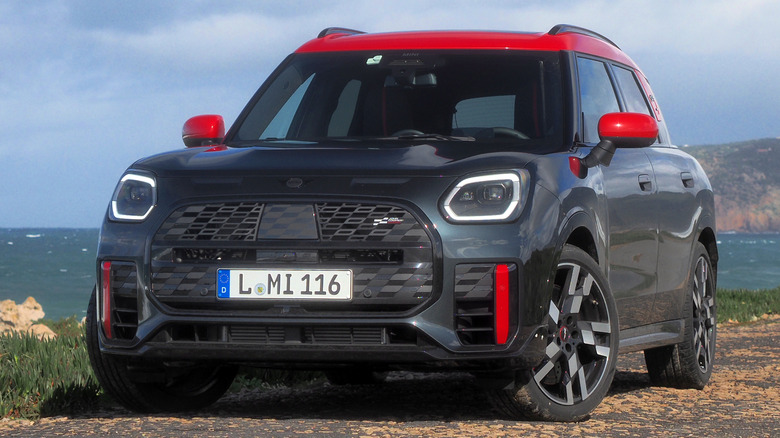
Chris Davies/SlashGear
MINI is growing up, though while a healthy embrace of electrification is on the menu for the 2025 model year, that’s not to say the giddy gasoline versions are going anywhere quite yet. See, for example, the 2025 MINI John Cooper Works Countryman ALL4: a long-named ploy to keep eager drivers grinning and growing families from straying from the automaker’s dealerships when it arrives there in May.
As before, there’s a BMW-sourced 2.0-liter turbocharged four-cylinder gas engine under the hood, though for the new JCW, that’s tuned for 312 horsepower and 295 pound-feet of torque. 0-62 mph arrives in 5.4 seconds, and there’s a top speed of 155 mph. Strong for a hot hatch, then, though straight line performance was never really what the MINI was about.
Instead, the goal here is giggles, though shareable with more people. MINI’s challenge with its biggest car is a tough balancing act: keep the whimsy, while also making it more practical. As you might expect, then, the results aren’t as clean-cut as they would be in a Cooper.
Sharper, brighter, meaner
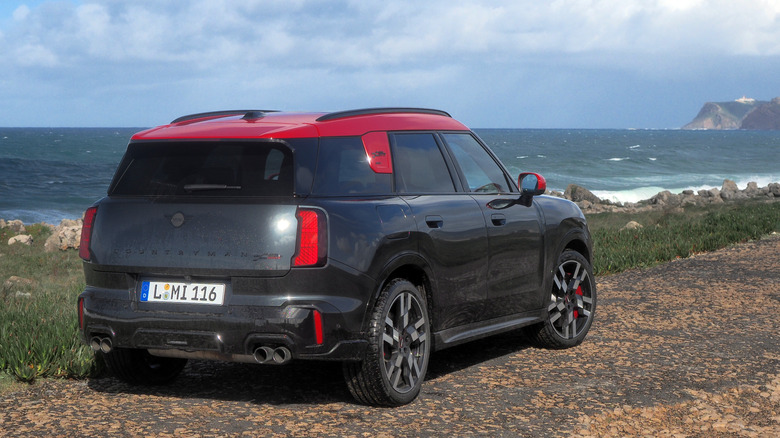
Chris Davies/SlashGear
Crisper and more tech-savvy describes the 2025 MINI Countryman’s design evolution. Some of the softer curves of the outgoing model have been sharpened, and the result looks a little more slab-sided and aggressive. A bigger front grille dives down into the lower fascia, while redesigned LED headlamps and taillamps have multi-segment clusters that can now not only animate when you approach and leave the car, but show different patterns depending on whether you went Countryman S, JCW, or the upcoming all-electric SE.
The result looks meaner, and more purposeful, though those who were fond of the round-eyed cheekiness of earlier iterations may find this latest Jon Cooper Works treatment has strayed too far. Perhaps the only truly awkward angle is from dead-on at the rear, where the upright LED clusters and slim glass can leave it looking pinched.
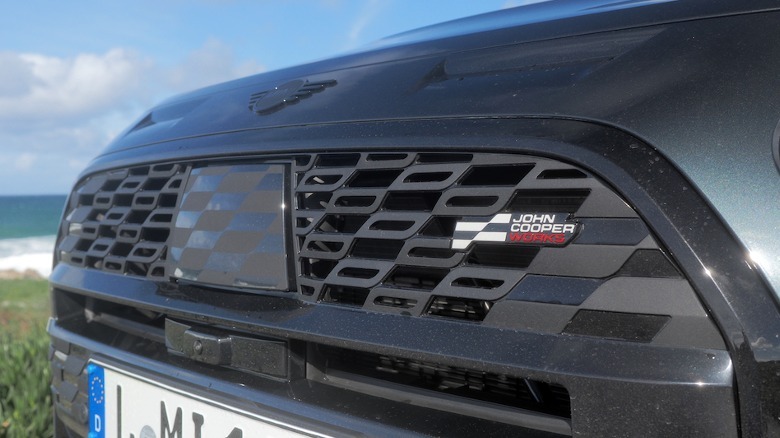
Now classed as an SUV in the U.S., the space behind that rear hatch does at least get more practical: there’s an uptick in trunk capacity, compared to the old car.
Longer, wider, taller
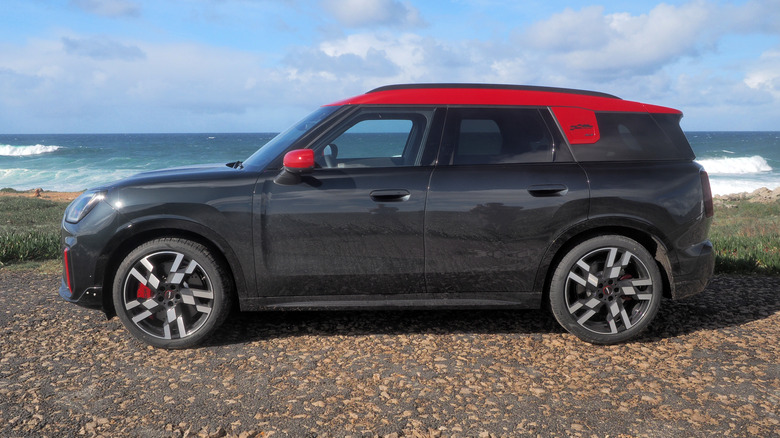
Chris Davies/SlashGear
Don’t be misled by how compact the MINI Countryman looks in photos, then. By now it’s a cliché to point out that, under BMW’s tenure, the MINI is no longer so … well, mini. Even compared to the earliest Cooper models from the rebooted brand, however, this 2025 Countryman is a big fellow.
At 14.6 feet long and 6 feet wide, it’s the biggest MINI so far. It’s the height, though, which really stands out: At 5.4 feet, it’s only about an inch lower than a BMW X3, despite being considerably shorter. MINI’s designers have done their best to hide some of that, with the contrast roof section thicker, but from the rear it still looks fairly tall and narrow.
MINI’s argument is that consumers want bigger cars, and in particular they want a step-up model within the automaker’s own range. The current lineup may be fine if you’re a couple, or perhaps a new family with a baby seat in the back, but once young teens hit growth spurts, the average MINI owner is likely to be looking for a larger vehicle — and, until now, that likely means with another brand’s badge on it. The Countryman aims to staunch that outflow.
More playful and more tech-savvy
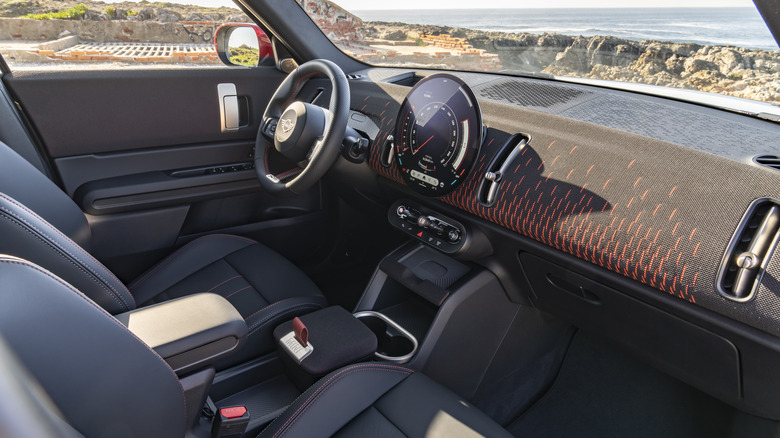
MINI
The payoff to the size increase is cabin space, as you’d hope. There’s room for four adults (or two adults and three smaller kids), with plenty of headroom and decent legroom. Unlike their counterparts at BMW, you can tell that MINI’s interior designers have been told to have fun. The new Countryman gets a dashboard clad in fabric, with a variety of multi-color and ombré finishes that are carried over to the door panels and seats.
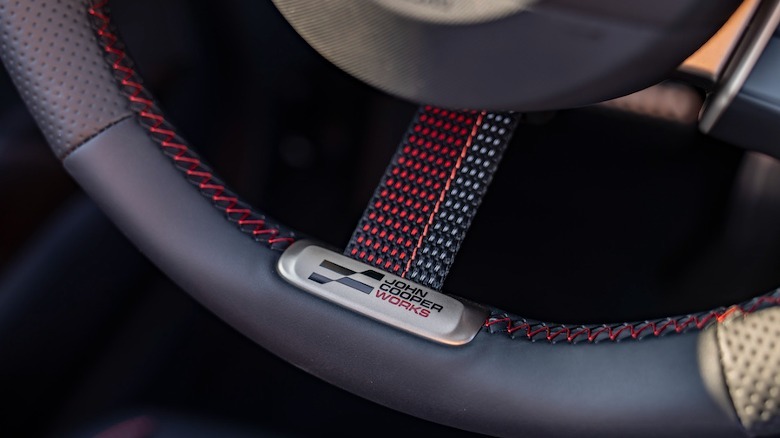
Fabric pulls to open storage cubbies, playful perforation on the faux-leather seat panels, and of course, a row of classic MINI toggles leave the cabin feeling charmingly fresh. It’s also a more ecologically-sustainable place to be, with reclaimed fabrics to go with recycled plastics; though it’s a shame some of the secondary aluminum MINI used for the alloy wheels didn’t find its way inside, too. Switchgear like the vent controls and door handles resemble metal, but turn out to be underwhelming plastic when you twiddle them.
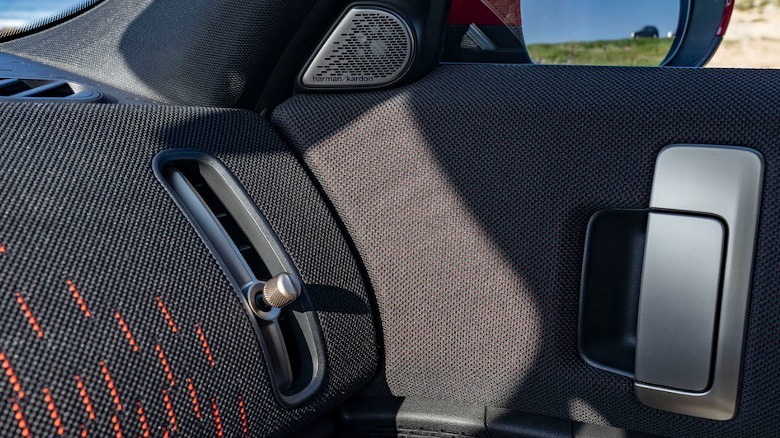
The most obvious interior change, though, is the new infotainment system. Now fronted by a big, circular OLED screen, it’s a thoroughly modern reinterpretation of the round gauges that have long been associated with the MINI brand. It also debuts MINI’s new infotainment system, with a homegrown UI designed to make the most of that touchscreen, and a «Hey MINI»-activated voice assistant.
Prepare for a learning curve
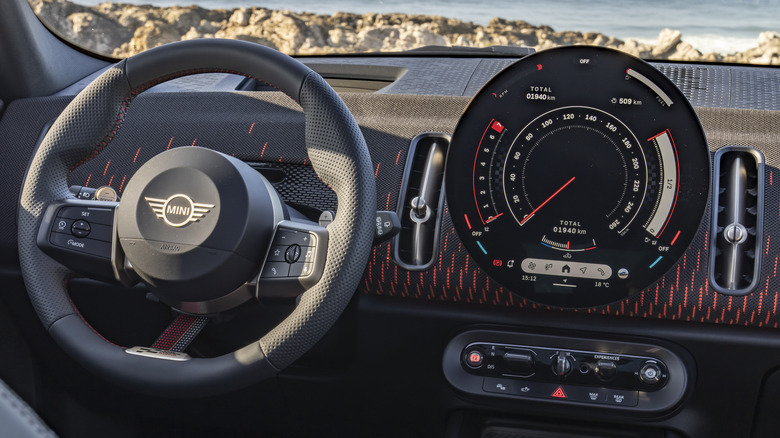
MINI
There’s certainly no confusing this new infotainment system with that of any other brand, including BMW. Its bright, playful, and comprehensive, and the huge, 9.4-inch diameter touchscreen is genuinely distinctive. An available heads-up display pops out of the dashboard in front of the driver to show the essentials like speed and upcoming navigation turns. You’re not constantly turning to look at the central screen.
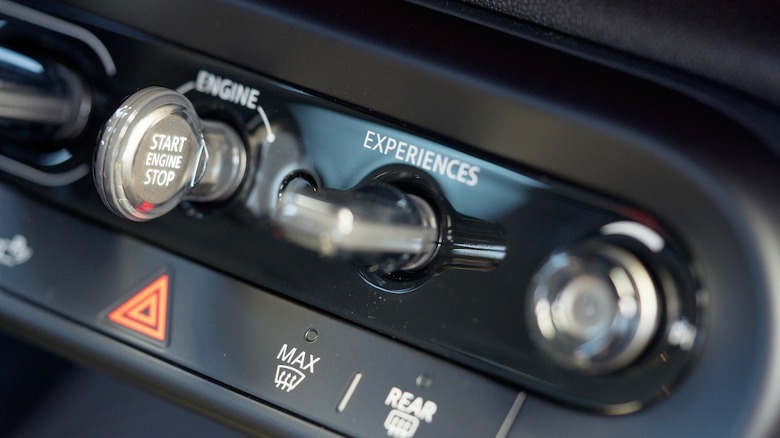
Not everything makes such sense, mind. There is, certainly, a steep learning curve involved, figuring out where the designers have spread different elements of the interface around the screen. Some of the simplified layouts — navigated between with a dedicated switch underneath — pare back the visual complexity, but there are still oddities. Not being able to drag your finger up and down the HVAC temperature graphics, for example — you tap them, and then tap the buttons that appear — feels counter-intuitive.
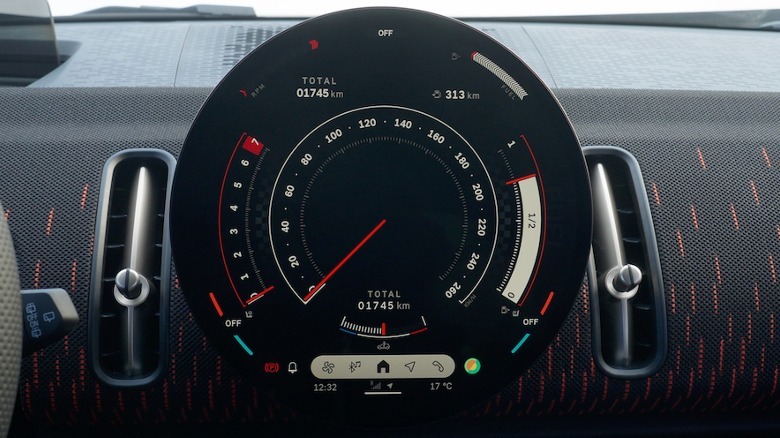
Wireless Apple CarPlay support is welcome, though the rectangular interface for the smartphone projection doesn’t quite fit with the MINI’s circular theme. Native apps for things like Spotify, though, might make connecting your phone less of a priority. MINI has definitely distinguished the eight different experience modes — from almost too knowingly-retro analog dials, through to trippy lava lamp-esque futurism — but that intentional style flourish makes it trickier to switch between them since just about everything moves around and is laid out differently.
The suspension is the biggest improvement
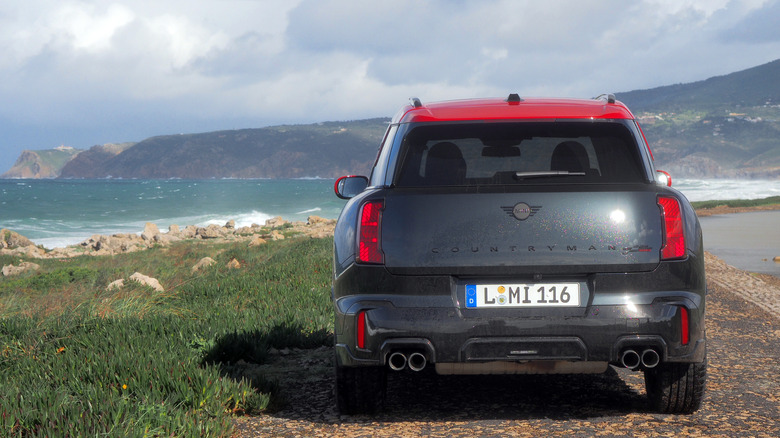
Chris Davies/SlashGear
For the most part, the new infotainment system is swift enough to jump through cleanly, though it definitely makes a lot of chimes and pings. There are 30 «earcons,» as MINI calls them — warning and notification noises, as the rest of us might think of them — and you’ll hear them regularly.
That’s on top of four different driving sounds, emphasized through the speakers — it doesn’t sound bad, actually, but you can turn it off for a more realistic, albeit subdued experience. Then there are light projections from behind the touchscreen, onto the surface of the dashboard itself.
In short, there’s a whole lot going on inside the MINI, and that matches the driving style of this John Cooper Works model. The best news is that, compared to the old version, the suspension has been dialed back from spine-destroying. Yes, that old car had adaptive suspension that could soften somewhat, but the result was «softer» rather than «soft»; find a twisty road and that was just swell, but for urban driving it was less of a joy.
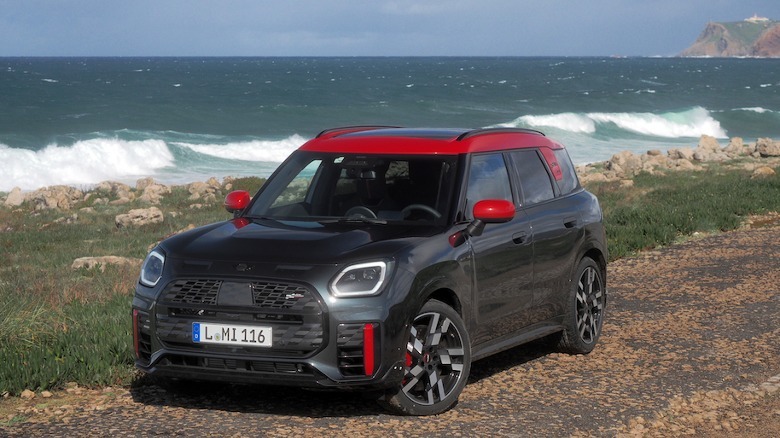
For the 2025 JCW Countryman, the spread of talents feels wider. Certainly, out in the backroads there’s a marked playfulness: the MINI still feels eager, even if the overall scale means it’s not as throwable as a Cooper. In the narrow lanes of Lisbon, Portugal, where MINI hosted SlashGear to test out its new car, laissez-faire locals and take-no-prisoners truck drivers left the Countryman feeling every bit of its width.
Perky, but not quite an all-rounder
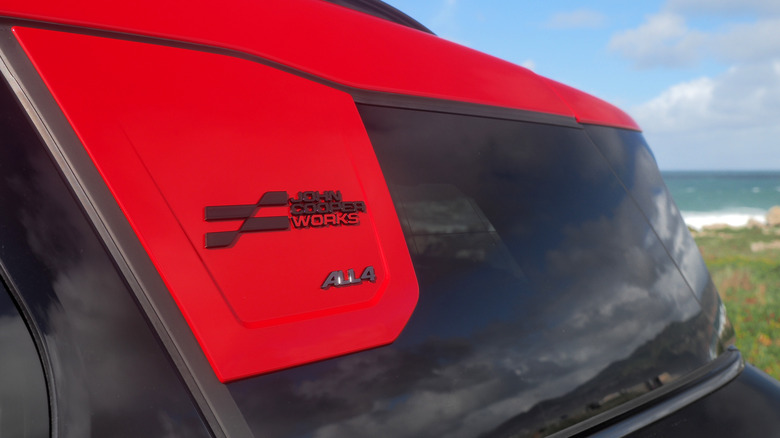
Chris Davies/SlashGear
Grip is plentiful, with the ALL4 all-wheel drive system smooth as it shuffles power around, but the JCW is not a particularly light car. Its curb weight — north of 3,600 pounds — is about the same as its predecessor, but combined with the extra width, it leaves the Countryman feeling burlier. The steering is crisp, and the brakes — vented front and rear — certainly up to the task, but we already knew MINI could make an eager driver’s car.
Where things feel most improved, indeed, is everywhere else beyond those whimsical roads. You might forgive a Cooper for being impractical in the name of dynamics, but the Countryman — even in JCW form — can’t be quite so single-minded. The good news is that it’s more enjoyable to drive in the city, where the precise steering, and slightly more compliant ride add up to a less punishing vehicle overall.
Unlike the eight-speed automatic of old, there’s a seven-speed Steptronic dual-clutch gearbox here in the 2025 car. It’s swift to shift when you’re pushing hard, and happily you don’t really need to reach for the steering wheel paddles (because, like the vent controls, they’re weirdly cheap-feeling plastic nubs).
The only time you might miss that eighth ratio is at highway speeds, when engine noise gets a little loud inside. At least MINI resisted the urge to swap the JCW’s 19″ or 20″ wheels for 21″ versions, which would likely have been even louder.
2025 MINI JCW Countryman ALL4 Verdict
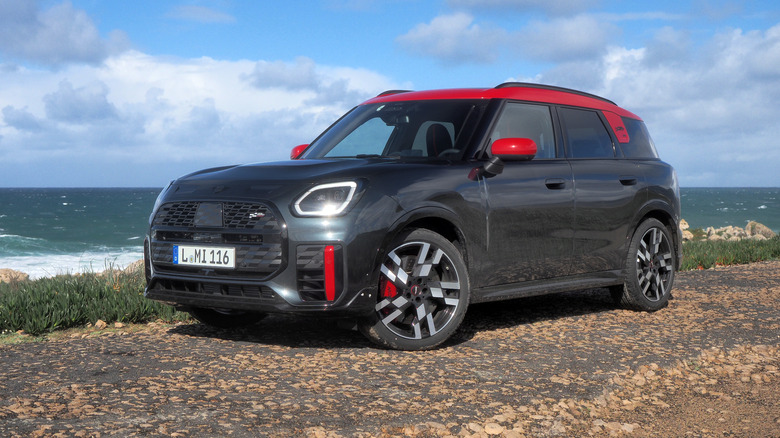
Chris Davies/SlashGear
On paper, the 2025 MINI John Cooper Works Countryman ALL4 seems like it ought to check off every box. More space and more power than before, with a ton more tech. The roughly $3K price bump — taking it to $46,900 (plus $995 destination) — might make you wince, but those changes plus more standard equipment help suck some of the sting. We’re still yet to see a final, all-encompassing price list to take into account the extras.
Decisions that would be forgivable on the JCW Cooper, though, sit a little less comfortably in this Countryman version. The overall scale says more family-friendly, but the ride is still decidedly firm. The most eager drivers, meanwhile, will bemoan the continued absence of a manual transmission. More damningly, the larger car just doesn’t quite encourage silliness of a sort that the JCW badge implies.
Arguably, the biggest challenge the new JCW Countryman faces, though, comes from its own siblings. The MINI Countryman S ALL4 may, at 241 horsepower, be down on horses, but it has the same 295 pound-feet of torque and will start at a hefty $8K less when it arrives later in 2024. Meanwhile, the Countryman SE ALL4’s all-electric drivetrain will have more horsepower and more torque.
You can’t blame MINI for trying to spread the JCW goodness, or broaden its Countryman appeal for that matter. Yet while the biggest MINI is undoubtedly improved in several ways, trying to do so much with one trim brings with it inevitable compromise, too. The strategy of keeping growing families in the MINI brand is a sensible one, but the John Cooper Works doesn’t feel like the best flavor for that approach.